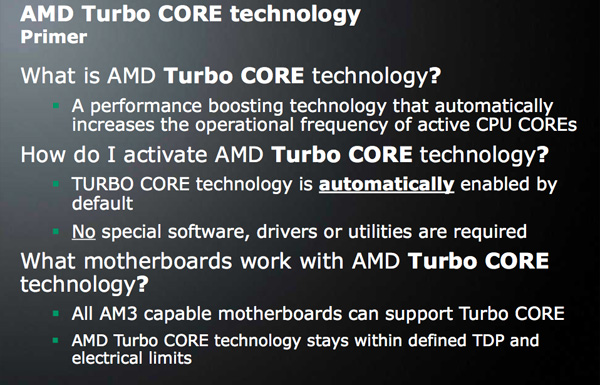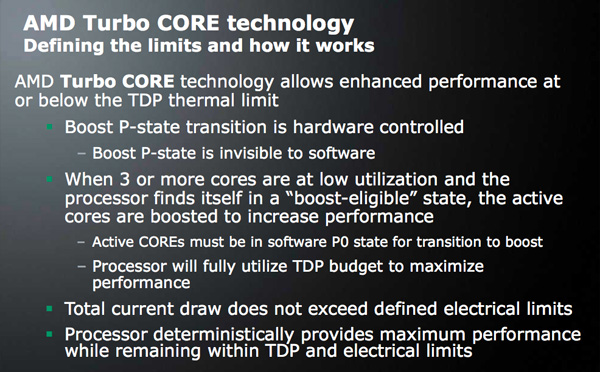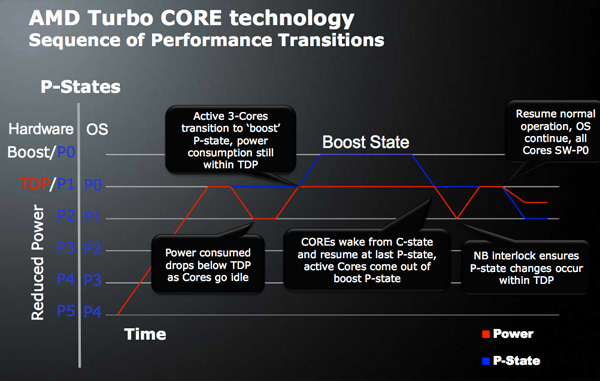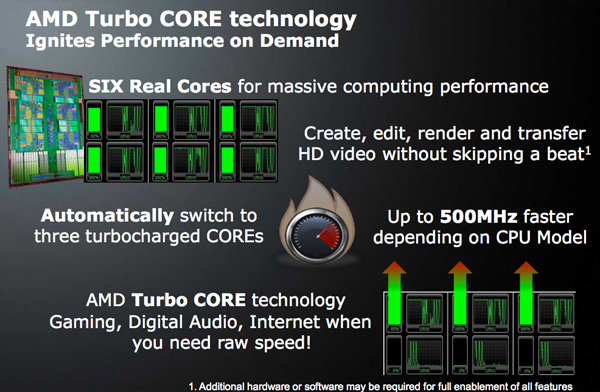AMD Divulges Phenom II X6 Secrets, Turbo Core Enabled
by Anand Lal Shimpi on April 8, 2010 12:00 AM ESTLast month Intel introduced its first desktop 6-core CPU, the 32nm Gulftown Core i7 980X. Running at 3.33GHz we loved the fact that it’s quite possibly the first Extreme Edition part that is able to justify its price. For $999 you get six cores and better performance all in the same power envelope as the current high end quad-core i7s.
The 980X is a great chip, but spending $999 on a single component in your PC is a tough sell for most folks. Luckily, AMD is coming out with its own 6-core processors codenamed Thuban. Below is what we know so far about AMD's Thuban lineup (note, the information in the table was not provided by AMD):
| AMD 2010 Roadmap | |||||||
| CPU | Clock Speed | Max Turbo (<= 3 cores) | L3 Cache | TDP | Release | ||
| AMD Phenom II X6 1090T | 3.2GHz | 3.6GHz | 6MB | 125W | Q2 | ||
| AMD Phenom II X6 1075T | 3.0GHz | 3.5GHz | 6MB | 125W | Q3 | ||
| AMD Phenom II X6 1055T | 2.8GHz | 3.3GHz | 6MB | 125W/95W | Q2 | ||
| AMD Phenom II X6 1035T | 2.6GHz | 3.1GHz | 6MB | 95W | Q2 | ||
| AMD Phenom II X4 960T | 3.0GHz | 3.4GHz | 6MB | 95W | Q2 | ||
Officially branded the Phenom II X6, AMD won’t be launching these processors until some time in the future. But today AMD is disclosing some basic details about the parts. We’re also mixing in our knowledge of internal AMD roadmaps to paint a clear picture of AMD’s 6-core strategy.
The more cores at the same TDP feature that Intel delivers with the 980X, AMD is also promising with Phenom II X6. The difference is that these are still 45nm parts. While we’ll have to test them to be sure, AMD currently indicates that the entire Phenom II X6 lineup will be rated at 95W or 125W TDPs. It’s all manufacturing tricks that make it possible (good job GlobalFoundries). In theory you should be able to buy a Phenom II X6 and have it operate in the same power envelope as a Phenom II X4 965.

With the Thuban cores AMD is introducing its version of Intel’s Turbo Boost technology called Turbo Core. AMD has yet to implement power gating on its processors, so Turbo Core works a little differently than Intel’s Turbo.
Turbo Core kicks in when 3 or more cores (on a 6-core part) are idle. When this happens, the frequency of those three cores is reduced to 800MHz, the voltage to the entire chip is increased, and the remaining three cores are turboed up by as much as 500MHz. It doesn’t get any more granular than this. If you have 3 or more cores idle, then the remaining turbo up. In any other situation the CPU runs at its normal clocks.

The CPU handles all monitoring and does the clock/voltage management itself. The switch to turbo up cores apparently happens fast enough to deal with Windows moving threads around from core to core.

Turbo core is triggered by a deterministic system that is based on load demand and current operating conditions (not temperature).
Cool’n’Quiet is active throughout the turbo process. What actually happens is that when CnQ looks to see if a set of cores should be downclocked, it also has the ability to increase the frequency of other cores.

This isn’t nearly as elegant of a solution as Intel’s turbo. The idle cores are never actually shut off, and voltage to all cores is increased to reach the higher clock speed. However if it works as advertised with no drawbacks (e.g. underclocking 3 cores when you actually still need them) then it’s definitely better than nothing for the Phenom II lineup. AMD will also have quad-core CPUs with turbo core support based on the new Thuban cores.
The great news? All Socket-AM3 and AM2+ motherboards will work with these new Phenom II X6 CPUs with nothing more than a BIOS update. The boards do have to support the TDPs the chips are rated for of course.
Pricing and performance are both unknowns at this point. We’ll keep you posted!










58 Comments
View All Comments
ExodusC - Thursday, April 8, 2010 - link
This is overdue, but a great thing.pjconoso - Thursday, April 8, 2010 - link
We're now seeing results from Intel's settlement with AMD :). Is this the one rumored to be $200-300? I want one!wicko - Thursday, April 8, 2010 - link
So I take it the cores are only overclocked when other cores are not in use? I guess with 6 cores you're bound to have some of them idle.ET - Thursday, April 8, 2010 - link
The article says twice "3 or fewer cores idle", when it clearly means "3 or more cores idle". From the description, it looks like it's actually just "if there are 3 idle cores, then 3 turbo up".InternetGeek - Thursday, April 8, 2010 - link
Here's an easier way to read it. The number of idle cores determines the number of cores that will be accelerated if there are more than 3 idle cores. So for 3 idle cores, 3 are accelerated; for 4 idle cores 2 are accelerated and so on. What this means is the more idle cores there are the more the active cores can be accelerated, up to 3.5ghz.What I also understand is that there won't be any power saving because regardless of which cores are idle or not, all will be overvolted. Must be because they all share the same power plane.
JumpingJack - Saturday, April 10, 2010 - link
This is not they way I understand it, but I could be wrong.... if 4 cores are idle, 3 cores still get accelerated, one is simply not used. Voltage goes up to all cores as well, so this chip will run as hot as 6 cores loaded, or maybe even hotter -- assuming this is indeed how it works.Power consumption will be an interesting thing to observe when this chip comes out.
neoflux - Thursday, April 8, 2010 - link
Yeah, the slide clearly says "if 3 or MORE are idle", not fewer.Also, the article makes it sounds like it's either 3 boost or none boost, whether or not it means that.
According to the slide it's either 3 idle = 3 boost, 4 idle = 2 boost, or 5 idle = 1 boost. Not as effective or efficient as Intel, but better than nothing.
PS- would it be terribly hard to keep the article showing along with the commenting box or even the other comments? Hard to give detailed comments when you can't see what you're replying to without opening article again on another tab.
Anand Lal Shimpi - Thursday, April 8, 2010 - link
Wow, long night, fixed :)And yes we have a lot of changes coming for the comment engine, they just didn't all make the cut for the launch list but we'll be adding things as we go along.
Take care,
Anand
Carleh - Thursday, April 8, 2010 - link
Would it be possible to add some left and right margins to print page layout? I know it's meant to be printed, but I guess a lot of readers use it to read the whole article at once (me included), and it is slightly inconvenient to read without margins. Thank you.Barneyk - Thursday, April 8, 2010 - link
Im really impressed by AMD and how they stay competitive with Intel even though Intel has such a huge lead right now.To bad they're not competitive enough to actually bring the prices down more on Intels mid-range to high-end levels.